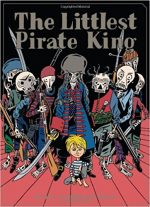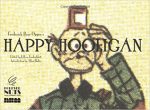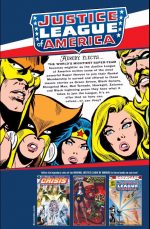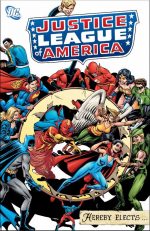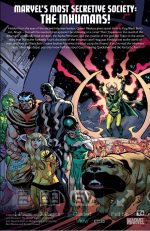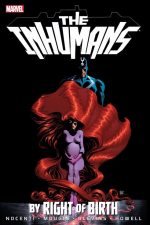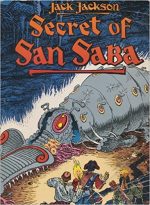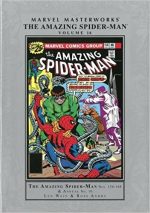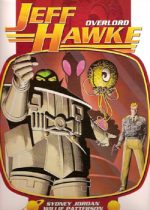
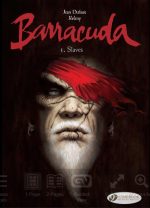
By Jean Dufaux & Jérémy Petiqueux translated by (Cinebook)
ISBN: 978-1-84918-165-5
Yo Ho-Ho, me Hearties: You know what day it is!
Pirates have been a cornerstone of popular fiction for centuries and these days the very best of the genre can usually be found issuing from European shores. An intriguing twist on the genre Рsimultaneously traditional and convention-challenging Рis Barracuda, told in six volumes by prolific, edgy writer Jean Dufaux (Crusade, Monsieur Noir, Jessica Blandy, Murena) and sublime illustrator/colourist J̩r̩my Petiqueux (Complainte des landes perdues, Murena, The Knights of Heliopolis).
This first volume – Barracuda 1 – Esclaves – was released continentally in 2010 and translated for the benefit of English-speakers by Cinebook three years later. A lusty tale of barbaric acts by desperate men, Slaves opens as a Spanish vessel transporting gold and nobles of great merit is challenged by the ruthless pirate ship Barracuda. Aboard the raider, captain Blackdog encourages his murderously capable boy Raffy before the bloodletting commences…
Aboard the doomed transport Doña Emelia Sanchez Del Scuebo attempts to protect her children. There is little she can do for pretty Maria, but at least Emilio has a chance of avoiding death, after mother dresses her darling boy in the clothing of a female servant…
When the defenders finally falter, Blackdog finds a moment for sport and entertainment as valiant seaman De La Loya finds himself the last man standing. Refusing to surrender, he is challenged to duel by bold Raffy. The fight is fast and furious but fortune favours the older man and the boy is humiliated by being spared from a noble death in return for the sailor’s liberty and freedom…
Whilst dividing the spoils and heading back to the pirate nest on Puerto Blanco, Blackdog discovers something of great value. The Del Scuebos possess a cursed gem of immeasurable value and his new captive holds a map to its horrific hidden location…
Hunger for the Kasura Diamond grips the pirate captain, and when the Barracuda reaches the hidden haven of the corsairs, he remains aboard ship, consulting with the township’s witch-woman Madame If-No rather than re-immerse himself in the literally cut-throat politics of the island…
Fate has other plans however, and when the captured women reach slave-master Ferrango‘s auction block the noble family are bought by agents of three covertly warring factions. The matron is purchased and rescued by the island’s supposedly neutral mission-monks The Companions of the Cross, but her pretty daughter is scooped up by the abusive slave-master himself.
Emilio – still considered by all to be mere maid-in-waiting Emilia – is sold for an astounding sum to the distant and incomprehensibly enigmatic Englishman Mr. Flynn…
In the harbour, Blackdog readies to ship out in search of the cursed diamond even as assorted factions act against each other in Puerto Blanco. When a monk-sponsored rescue bid falters a desperate pursuit of little Maria goes brutally awry and Raffy is severely wounded. Although If-No saves his life, the boy is too ill to sail with his father and remains on the island as intrigues and double-dealing seem set to topple Puerto Blanco’s elected Governor.
As a woman in the Pirate Brotherhood, her position has always been precarious, but with rumours abounding of Blackdog’s mystery voyage tension and dissent mount to a deadly pitch.
And then the Barracuda is gone, slipping into the night in search of untold bounty and risking the wrath of hell itself…
To Be Continued…
Lavishly realised and deviously contrived, this carefully considered saga of sinister swashbucklers and fearsome freebooters gradually unfolds with measured pace, carefully nudging its ensemble cast – with not a hero in the bunch – towards an unknown but certainly violent and thrilling conclusion. Along the way the reader can enjoy the juggling of family tensions, wicked ambition, political chicanery, rapacious greed and obsessive vengeance with the spin only sea-action and supernatural terror can provide…
This is pure genre wonderment: unmissable stuff which could only be improved upon by being read on a sandy beach or near rocky caves with lapping surf and constantly crashing waves…
© Dargaud, Benelux (Dargaud – Lombard s. a. 2010 by Dufaux & Jérémy. All rights reserved. English translation © 2013 Cinebook Ltd.

